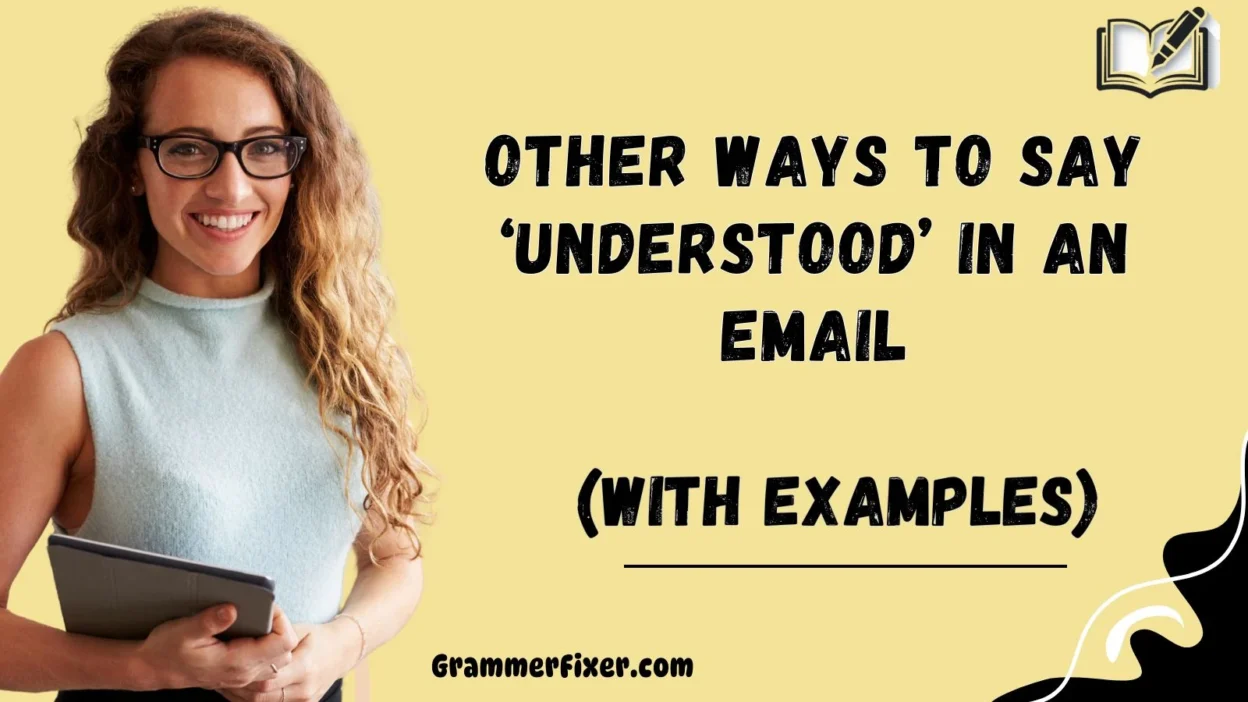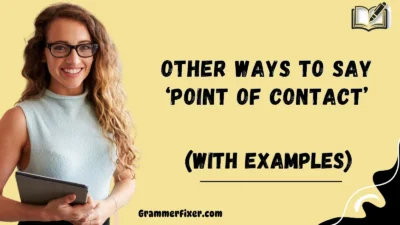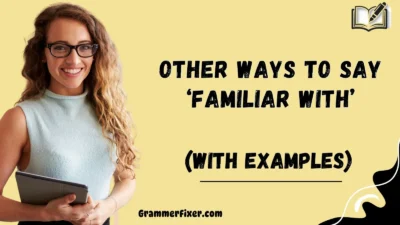Finding the right words in an email can make a significant difference in how your message is received. While a simple “Understood” gets the point across, exploring other ways to communicate comprehension can make your email feel warmer, more thoughtful, and professional.
Using the right phrasing not only conveys clarity, but also shows respect for the recipient’s perspective, making your interactions more meaningful.
What Does “Understood” Mean?
“Understood” indicates that you have comprehended the message, instruction, or idea conveyed. It signals acknowledgment without necessarily implying agreement. In emails, it’s often used to confirm receipt of information or instructions.
When to Use “Understood”?
Use “Understood” when you want to confirm comprehension in a concise and professional way. It works well in team communications, project updates, or when acknowledging instructions. However, the tone can vary depending on context—friendly, formal, or neutral.
Is It Professional/Polite to Say “Understood”?
Yes. Saying “Understood” is professional, concise, and clear. But overuse can feel impersonal. That’s why exploring alternatives can enhance communication, build rapport, and avoid monotony.
Pros or Cons
Pros:
- Concise and clear
- Signals acknowledgment
- Suitable for professional contexts
Cons:
- May seem cold or dismissive if overused
- Lacks warmth or personalization
- Can feel repetitive in ongoing conversations
1. Got It
Meaning: Confirms you have grasped the message.
Detailed Explanation: Informal yet clear, suitable for casual professional settings.
Scenario Example: “Got it, I’ll update the report by EOD.”
Best Use: Quick replies with colleagues or peers.
Worst Use: Avoid in formal emails or executive correspondence—may seem too casual.
Tone: Friendly, concise, informal.
2. Duly Noted
Meaning: Acknowledges receipt and understanding formally.
Detailed Explanation: Signals attention and record-keeping.
Scenario Example: “Your feedback has been duly noted, and we’ll adjust the plan accordingly.”
Best Use: Formal emails, HR communication, executive correspondence.
Worst Use: Avoid in informal team chats—can sound stiff or distant.
Tone: Polite, formal, professional.
3. Point Taken
Meaning: Indicates understanding, especially of a perspective or criticism.
Detailed Explanation: Shows empathy and acknowledgment without necessarily agreeing.
Scenario Example: “Point taken, I’ll ensure the next draft reflects your suggestions.”
Best Use: Constructive feedback or discussions.
Worst Use: Avoid when you fully agree and want to show enthusiasm—it may seem lukewarm.
Tone: Empathetic, reflective, thoughtful.
4. That’s Clear
Meaning: Confirms clarity of the information received.
Detailed Explanation: Communicates comprehension and readiness to act.
Scenario Example: “That’s clear. I’ll proceed with the next steps.”
Best Use: Instructions, project planning, brief updates.
Worst Use: Avoid when you need to convey agreement or emotional support—it’s neutral and may feel detached.
Tone: Direct, professional, concise.
5. I’m Aligned
Meaning: Shows agreement and understanding in a collaborative context.
Detailed Explanation: Expresses shared vision or approach.
Scenario Example: “I’m aligned with the strategy outlined and will coordinate with the team accordingly.”
Best Use: Team projects, strategic discussions.
Worst Use: Avoid if you are not fully committed—it can be misinterpreted as agreement.
Tone: Collaborative, professional, positive.
6. Thank You for the Information
Meaning: Expresses acknowledgment while appreciating the sender.
Detailed Explanation: Adds a touch of gratitude to your confirmation.
Scenario Example: “Thank you for the information; I’ll review it and follow up promptly.”
Best Use: Formal updates, receiving new instructions or insights.
Worst Use: Avoid in repetitive situations where the sender expects a simple acknowledgment—it may come across as verbose.
Tone: Polite, warm, professional.
7. I Will Get Back to You
Meaning: Indicates that you have understood but need time before responding.
Detailed Explanation: Useful for showing acknowledgment while buying time to gather information or prepare a response.
Scenario Example: “I’ve received your proposal and will get back to you with detailed feedback by tomorrow.”
Best Use: When instructions require follow-up or analysis.
Worst Use: Avoid using too frequently without action—it may seem evasive or noncommittal.
Tone: Polite, professional, proactive.
8. Acknowledged
Meaning: Confirms receipt and comprehension of the message.
Detailed Explanation: Clear and professional, often used in formal or structured environments.
Scenario Example: “Acknowledged. I’ll ensure the report is ready for review by EOD.”
Best Use: Formal emails, instructions from supervisors, project updates.
Worst Use: Avoid in casual team conversations—it may feel robotic.
Tone: Professional, concise, neutral.
9. Noted
Meaning: Indicates that the information has been received and understood.
Detailed Explanation: Quick, concise acknowledgment suitable for formal communication.
Scenario Example: “Noted. We will proceed with the revised timeline.”
Best Use: Brief updates, confirmations, acknowledging instructions.
Worst Use: Avoid overuse—it can feel dismissive if repeatedly used without follow-up.
Tone: Formal, concise, professional.
10. Received
Meaning: Confirms that the email or information has been received.
Detailed Explanation: Simple acknowledgment that shows you are aware of the message.
Scenario Example: “Received. I’ll review the materials and provide feedback.”
Best Use: Quick confirmations of documents, reports, or files.
Worst Use: Avoid as the only response for complex instructions—it may seem inattentive.
Tone: Neutral, direct, professional.
11. Comprehended
Meaning: Demonstrates full understanding of the instructions or information.
Detailed Explanation: Formal, often used in technical, analytical, or academic contexts.
Scenario Example: “The steps outlined are comprehended; I’ll implement them accordingly.”
Best Use: Technical instructions, academic or structured communications.
Worst Use: Avoid in casual emails—it may sound overly stiff or unnatural.
Tone: Formal, precise, professional.
12. Grasped
Meaning: Indicates you have captured the main idea or essence of the message.
Detailed Explanation: Slightly informal, conveys understanding of key points.
Scenario Example: “I’ve grasped the proposed changes and will adjust our approach.”
Best Use: Team discussions, project updates, collaborative settings.
Worst Use: Avoid in formal correspondence—it may feel too casual.
Tone: Friendly, professional, clear.
13. Clear
Meaning: Confirms clarity of the instructions or information.
Detailed Explanation: Direct, concise, and effective in showing understanding.
Scenario Example: “Clear. I’ll proceed as outlined in the plan.”
Best Use: Quick confirmations in professional settings.
Worst Use: Avoid when you want to show empathy or engagement—it may feel neutral or detached.
Tone: Direct, professional, concise.
14. I See
Meaning: Signals comprehension and attentiveness to the sender’s message.
Detailed Explanation: Friendly and empathetic, can convey active listening.
Scenario Example: “I see. I’ll take these points into account during our next phase.”
Best Use: Collaborative discussions, feedback sessions, email replies showing understanding.
Worst Use: Avoid in highly formal emails—it may appear too casual.
Tone: Empathetic, friendly, conversational.
15. Appreciate the Update
Meaning: Confirms understanding while showing gratitude.
Detailed Explanation: Warm acknowledgment that conveys respect for the sender’s effort.
Scenario Example: “Appreciate the update. I’ll align with the team and proceed.”
Best Use: Updates, reports, project milestones, professional communications.
Worst Use: Avoid for minor, routine messages where brevity is preferred.
Tone: Polite, warm, professional.
16. Crystal Clear
Meaning: Strong confirmation of full understanding.
Detailed Explanation: Emphasizes absolute clarity and readiness to act.
Scenario Example: “Crystal clear. I’ll execute the tasks as outlined.”
Best Use: Critical instructions or high-stakes communications.
Worst Use: Avoid in casual or informal settings—it may sound exaggerated.
Tone: Confident, direct, professional.
17. All Good
Meaning: Casual confirmation that everything is understood or okay.
Detailed Explanation: Friendly, informal acknowledgment of comprehension.
Scenario Example: “All good. I’ve noted the timeline changes.”
Best Use: Informal team communications, peer interactions.
Worst Use: Avoid in formal or executive emails—it may seem too casual or careless.
Tone: Friendly, informal, relaxed.
18. I’ve Got That
Meaning: Indicates understanding and readiness to act.
Detailed Explanation: Informal, conversational, often used in team messaging.
Scenario Example: “I’ve got that. Will ensure the deliverables are ready by Friday.”
Best Use: Team chats, quick internal updates.
Worst Use: Avoid in formal client or senior-level emails—it may appear unprofessional.
Tone: Friendly, casual, concise.
19. Message Received
Meaning: Confirms receipt and understanding of the message.
Detailed Explanation: Slightly formal, often used in professional correspondence.
Scenario Example: “Message received. I’ll review the documents and follow up accordingly.”
Best Use: Official communication, project tracking, internal updates.
Worst Use: Avoid overusing—it may feel impersonal if repeated frequently.
Tone: Professional, neutral, concise.
20. Understood and Acknowledged
Meaning: Strong confirmation of comprehension and receipt.
Detailed Explanation: Formal and professional, emphasizes attentiveness.
Scenario Example: “Understood and acknowledged. I will proceed with the outlined steps.”
Best Use: Formal instructions, executive communications, compliance scenarios.
Worst Use: Avoid in casual interactions—it may come across as overly formal or rigid.
Tone: Formal, professional, confident.
21. Taken into Account
Meaning: Indicates the information or feedback will be considered.
Detailed Explanation: Shows attentiveness and willingness to act appropriately.
Scenario Example: “Your suggestions have been taken into account for the revised proposal.”
Best Use: Feedback, planning discussions, project adjustments.
Worst Use: Avoid when immediate action is expected—it may imply delay.
Tone: Professional, considerate, thoughtful.
22. Aware
Meaning: Signals awareness and understanding.
Detailed Explanation: Neutral acknowledgment suitable for professional contexts.
Scenario Example: “I’m aware of the updated deadlines and will plan accordingly.”
Best Use: Status updates, reminders, project tracking.
Worst Use: Avoid in casual settings—it may sound curt or detached.
Tone: Neutral, professional, concise.
23. Copy That
Meaning: Informal confirmation, often used in team or operational contexts.
Detailed Explanation: Friendly and quick acknowledgment of understanding.
Scenario Example: “Copy that. I’ll implement the changes as discussed.”
Best Use: Team chats, casual operational emails, project coordination.
Worst Use: Avoid in formal emails—it may seem unprofessional.
Tone: Casual, concise, friendly.
24. I’m Aware
Meaning: Confirms you know and understand the information.
Detailed Explanation: Slightly more formal than “Aware,” emphasizes attentiveness.
Scenario Example: “I’m aware of the client’s concerns and will address them promptly.”
Best Use: Professional communication, project updates, issue tracking.
Worst Use: Avoid using repeatedly—it may seem repetitive or detached.
Tone: Professional, neutral, polite.
25. Confirmed
Meaning: Signals comprehension and agreement or verification.
Detailed Explanation: Formal acknowledgment often used in instructions or planning.
Scenario Example: “Confirmed. The revised timeline is noted, and the team will follow accordingly.”
Best Use: Formal project updates, instructions, confirmations with executives.
Worst Use: Avoid in casual emails—it may sound rigid or cold.
Tone: Professional, concise, authoritative.
26. Right
Meaning: Informal acknowledgment of understanding.
Detailed Explanation: Short, friendly confirmation suitable for casual contexts.
Scenario Example: “Right, I’ll make the adjustments by tomorrow.”
Best Use: Internal team messages, informal exchanges.
Worst Use: Avoid in formal or sensitive communications—it may appear dismissive.
Tone: Casual, friendly, direct.
27. Sure
Meaning: Informal confirmation of comprehension and willingness to act.
Detailed Explanation: Polite yet casual, often used in conversational emails.
Scenario Example: “Sure, I’ll follow up with the client and update you.”
Best Use: Casual team emails, peer collaboration.
Worst Use: Avoid in formal or critical emails—it may seem too casual or noncommittal.
Tone: Friendly, casual, approachable.
28. I See Where You’re Coming From
Meaning: Shows empathy and comprehension of the sender’s perspective.
Detailed Explanation: Ideal for sensitive discussions or feedback scenarios.
Scenario Example: “I see where you’re coming from and will revise the proposal accordingly.”
Best Use: Feedback, conflict resolution, collaborative planning.
Worst Use: Avoid when immediate action is required—it may sound reflective rather than proactive.
Tone: Empathetic, professional, thoughtful.
29. That Makes Sense
Meaning: Signals understanding and logical alignment with the sender’s point.
Detailed Explanation: Shows comprehension and agreement with reasoning.
Scenario Example: “That makes sense. I’ll adjust the budget as suggested.”
Best Use: Feedback sessions, clarifying instructions, collaborative emails.
Worst Use: Avoid when you want to show neutral acknowledgment—it may imply agreement when none is intended.
Tone: Friendly, logical, professional.
30. I Understand Your Point of View
Meaning: Demonstrates comprehension and empathy for the sender’s opinion.
Detailed Explanation: Formal and considerate acknowledgment, especially useful in discussions or negotiations.
Scenario Example: “I understand your point of view and will incorporate your suggestions into the plan.”
Best Use: Professional feedback, conflict resolution, collaborative decisions.
Worst Use: Avoid in very casual emails—it may feel unnecessarily formal or heavy.
Tone: Empathetic, professional, respectful.
Conclusion
Finding the right way to say “Understood” in an email goes beyond mere acknowledgment—it’s about conveying comprehension with care, clarity, and professionalism. The alternatives outlined in this article allow you to tailor your message to the tone, context, and recipient, whether you want to be formal, empathetic, collaborative, or friendly.



